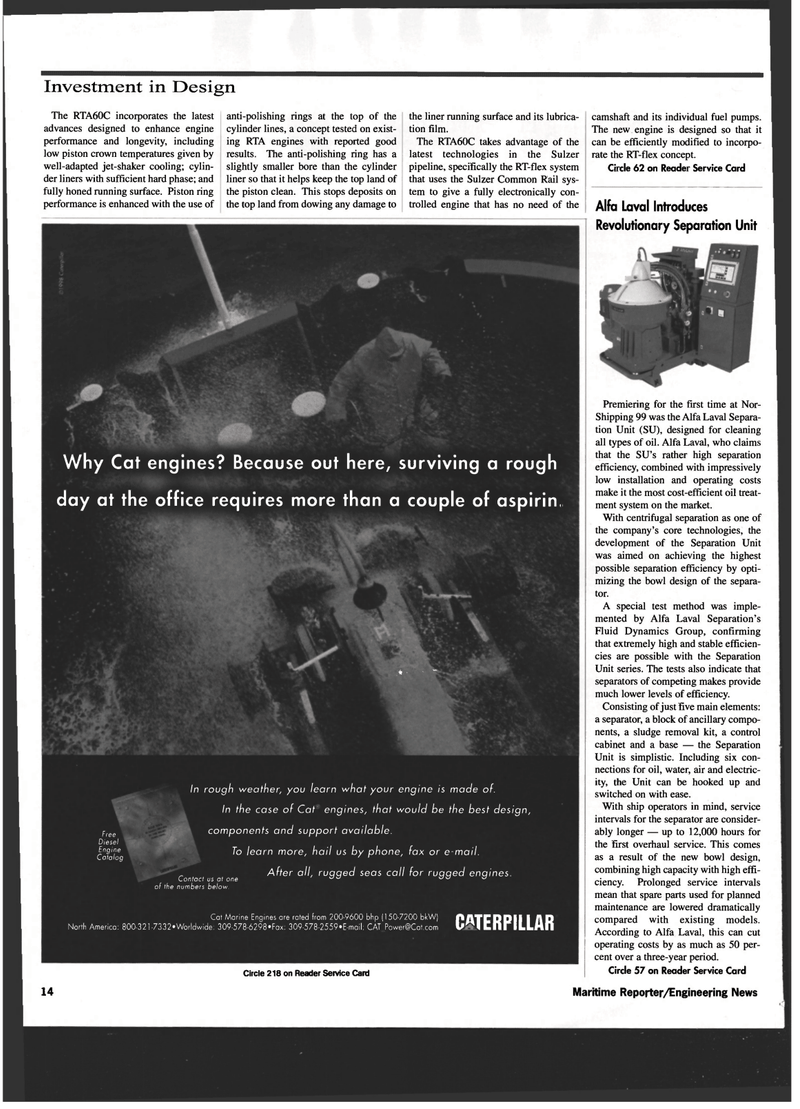
Page 14: of Maritime Reporter Magazine (July 1999)
Read this page in Pdf, Flash or Html5 edition of July 1999 Maritime Reporter Magazine
Investment in Design
The RTA60C incorporates the latest advances designed to enhance engine performance and longevity, including low piston crown temperatures given by well-adapted jet-shaker cooling; cylin- der liners with sufficient hard phase; and fully honed running surface. Piston ring performance is enhanced with the use of anti-polishing rings at the top of the cylinder lines, a concept tested on exist- ing RTA engines with reported good results. The anti-polishing ring has a slightly smaller bore than the cylinder liner so that it helps keep the top land of the piston clean. This stops deposits on the top land from dowing any damage to the liner running surface and its lubrica- tion film.
The RTA60C takes advantage of the latest technologies in the Sulzer pipeline, specifically the RT-flex system that uses the Sulzer Common Rail sys- tem to give a fully electronically con- trolled engine that has no need of the camshaft and its individual fuel pumps.
The new engine is designed so that it can be efficiently modified to incorpo- rate the RT-flex concept.
Circle 62 on Reader Service Card
Alfa Laval Introduces
Revolutionary Separation Unit
Premiering for the first time at Nor-
Shipping 99 was the Alfa Laval Separa- tion Unit (SU), designed for cleaning all types of oil. Alfa Laval, who claims that the SU's rather high separation efficiency, combined with impressively low installation and operating costs make it the most cost-efficient oil treat- ment system on the market.
With centrifugal separation as one of the company's core technologies, the development of the Separation Unit was aimed on achieving the highest possible separation efficiency by opti- mizing the bowl design of the separa- tor.
A special test method was imple- mented by Alfa Laval Separation's
Fluid Dynamics Group, confirming that extremely high and stable efficien- cies are possible with the Separation
Unit series. The tests also indicate that separators of competing makes provide much lower levels of efficiency.
Consisting of just five main elements; a separator, a block of ancillary compo- nents, a sludge removal kit, a control cabinet and a base — the Separation
Unit is simplistic. Including six con- nections for oil, water, air and electric- ity, the Unit can be hooked up and switched on with ease.
With ship operators in mind, service intervals for the separator are consider- ably longer — up to 12,000 hours for the first overhaul service. This comes as a result of the new bowl design, combining high capacity with high effi- ciency. Prolonged service intervals mean that spare parts used for planned maintenance are lowered dramatically compared with existing models.
According to Alfa Laval, this can cut operating costs by as much as 50 per- cent over a three-year period.
Circle 57 on Reader Service Card
Why Cat engines? Because out here, surviving a rough day at the office requires more than a couple of aspirin,
J** •"
In rough weather, you learn what your engine is made of.
In the case of Cat engines, that would be the best design,
Free
Diesel
Engine
Catalog components and support available.
Contact us at one of the numbers below.
To learn more, hail us by phone, fax or e-mail.
After all, rugged seas call for rugged engines.
Cat Marine Engines are rated from 200-9600 bhp (150-7200 bkW] P ATCDDII IAD
North America: 800-32l-7332»Worldwide: 309-578-6298»Fax: 309-578-2559*E-mail: CAT [email protected] WSJ £111 ILLHII
Circle 218 on Reader Service Card 14 Maritime Reporter/Engineering News

 13
13

 15
15
